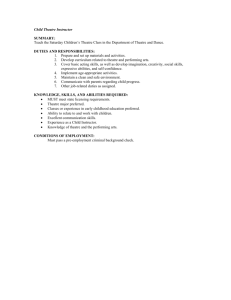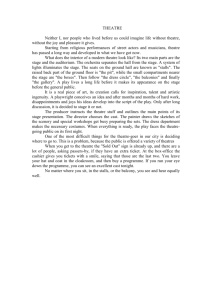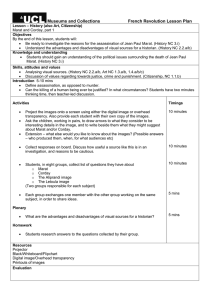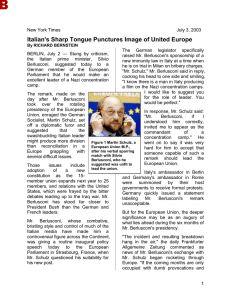Festival u paradise regained
advertisement
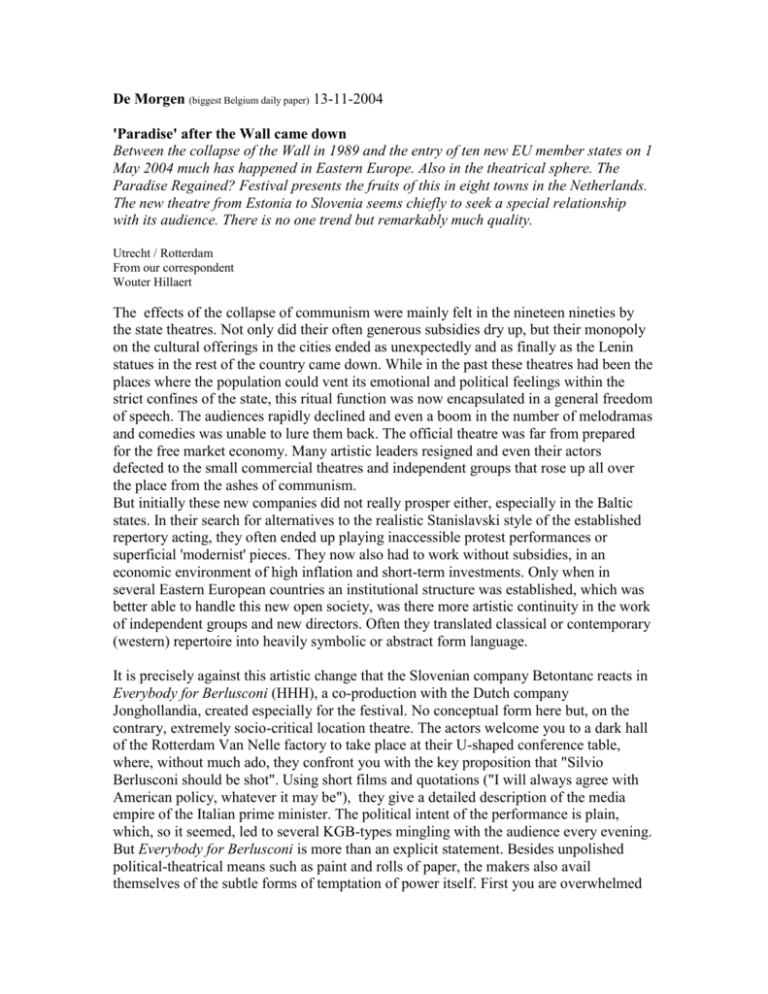
De Morgen (biggest Belgium daily paper) 13-11-2004 'Paradise' after the Wall came down Between the collapse of the Wall in 1989 and the entry of ten new EU member states on 1 May 2004 much has happened in Eastern Europe. Also in the theatrical sphere. The Paradise Regained? Festival presents the fruits of this in eight towns in the Netherlands. The new theatre from Estonia to Slovenia seems chiefly to seek a special relationship with its audience. There is no one trend but remarkably much quality. Utrecht / Rotterdam From our correspondent Wouter Hillaert The effects of the collapse of communism were mainly felt in the nineteen nineties by the state theatres. Not only did their often generous subsidies dry up, but their monopoly on the cultural offerings in the cities ended as unexpectedly and as finally as the Lenin statues in the rest of the country came down. While in the past these theatres had been the places where the population could vent its emotional and political feelings within the strict confines of the state, this ritual function was now encapsulated in a general freedom of speech. The audiences rapidly declined and even a boom in the number of melodramas and comedies was unable to lure them back. The official theatre was far from prepared for the free market economy. Many artistic leaders resigned and even their actors defected to the small commercial theatres and independent groups that rose up all over the place from the ashes of communism. But initially these new companies did not really prosper either, especially in the Baltic states. In their search for alternatives to the realistic Stanislavski style of the established repertory acting, they often ended up playing inaccessible protest performances or superficial 'modernist' pieces. They now also had to work without subsidies, in an economic environment of high inflation and short-term investments. Only when in several Eastern European countries an institutional structure was established, which was better able to handle this new open society, was there more artistic continuity in the work of independent groups and new directors. Often they translated classical or contemporary (western) repertoire into heavily symbolic or abstract form language. It is precisely against this artistic change that the Slovenian company Betontanc reacts in Everybody for Berlusconi (HHH), a co-production with the Dutch company Jonghollandia, created especially for the festival. No conceptual form here but, on the contrary, extremely socio-critical location theatre. The actors welcome you to a dark hall of the Rotterdam Van Nelle factory to take place at their U-shaped conference table, where, without much ado, they confront you with the key proposition that "Silvio Berlusconi should be shot". Using short films and quotations ("I will always agree with American policy, whatever it may be"), they give a detailed description of the media empire of the Italian prime minister. The political intent of the performance is plain, which, so it seemed, led to several KGB-types mingling with the audience every evening. But Everybody for Berlusconi is more than an explicit statement. Besides unpolished political-theatrical means such as paint and rolls of paper, the makers also avail themselves of the subtle forms of temptation of power itself. First you are overwhelmed by a flashy TV show in a Coliseum jump castle, accompanied by the drone of stirring music. Then you are manipulated emotionally by a close-up of Marleen Scholten who tearfully calls for a suicide attack on Berlusconi. Here we immediately see the difference with the classical socio-drama of the nineteen seventies. Although this performance at times also threatens to break up into short concrete scenes, we do see a more complex treatment of the central message developing. From postmodernism a certain irony seems to have been retained, which allows your critical viewing to become just that little bit more engagé. Irony, it appeared, was also one of the most interesting cultural differences between the Dutch and the Slovenians, as was apparent during the preparations. "From the theatre tradition before the break-up of Yugoslavia we have retained a greater sense of seriousness. In our country, an actor has much more status. If in this country you say you are an artist, you see people sneer, while in Slovenia you immediately get respect. But we learnt much from the humour and lightness with which Jonghollandia tackled the subject, while they suddenly started to wonder whether their typical sense of perspective really is the best way to address an audience. We ended up somewhere in the middle", says Branko Jordan of Betontanc, which was formed in 1990 in Ljubljana and who will also be represented at Paradise Regained? with the dance performance Wrestling Dostoevsky. In an equally direct manner, the Hungarian Krétakör Theatre plays on the audience in The Sea Gull (HHHH). Director Ărpăd Schilling stages the Chekov piece about unfulfilled artistic careers and failed loves throughout without light, décors or costumes. The actors join the audience on the stands and play their roles equally straightforward, with the open and individual style of acting we know from STAN. Much less than West European productions, however, they call attention to a supposed dark melancholy in the piece. They laugh or shout more loudly but do allow the text to speak for itself. The effect is so disarming that it gives you the feeling that these personalities are reinventing the essence of theatre on the spot. When in a special edition of the magazine Theatermaker Schilling says that "our background, this dual knowledge, is a great gift for us, and offers added value to you", you do not doubt him for a second.. In stark contrast to this is Oedipus Rex (HHH) by the Lithuanian top director Oskaras Korsunovas. To him, all theatre starts with children in the playground, and hence the setting is a metaphorical playground with a seesaw, roundabout and swings. The equipment is rigidly designed, just as the performance itself. Each response is accompanied by extremely precise gestures, with simultaneous beats by a live percussionist. When applied to the choir, who wear large baby and dog masks, the effect is at times one of a brilliant rhythmical dynamics, but when the dialogues between Oedipus, Creon or Iokaste are long, this highbrow Disney threatens to become a bit too much. Like the destiny of his title character, Oedipus continually balances on the seesaw. On the one hand, the oppressive light and musical images make it an interesting technical translation for the human-transcending drama in this classic detective. On the other, sterile formalism lurks. Most 'typically modern Eastern European' in nature is Marat/Sade (HHH) by Javor Gardev and the Bulgarian Triumviratus Art Group. The theme of this production is the sense and nonsense of revolution. In Peter Weiss's original piece Marquis De Sade uses the French Asylum of Charenton to perform a play about Jean-Paul Marat, one of the most extreme leaders of the French Revolution. The play-in-the-play juxtaposes Marat's view on eternal rebellion ("the blood must continue to flow") with De Sade's more perverted-physical interpretation of the anti-bourgeois struggle. Between them stand the people, grumbling because they are hungry. Gardev shows a motley crowd of bingeing whores, punks and junks. One of the messages of this play seems to be their rise and fall in a feast that is capitalism. Another could be that the new Europe (which Bulgaria is not yet part of) is an idea hankered after by the rulers rather than by the peoples themselves. Besides the complex ideas, it is the form that prevails in Marat/Sade. When the Hungarian author Andreás Forgách describes contemporary Eastern European theatre as "pure provocation, physical presence, a bit of sex and violence on the stage, and the incorporation of a new media aesthetics" this play is the living proof of this. Just like the East German director Frank Castorf, Gardev integrates live video images from, for example, the toilets outside the hall. Except that here these images with their psychedelic graininess become their own style characteristic. The performance intends to be a postmodern ritual, centring around ideas about physicality, which are highly reminiscent of Fabre. Visually it looks good, but what it actually means is hard to fathom. This tells you that even in a united Europe cultural differences continue to play an important role. It is precisely this confrontation that makes Paradise Regained? (which also counts successful directors such as Krzysztof Warlikowski and Alvis Hermanis among its guests) well worth a visit.



